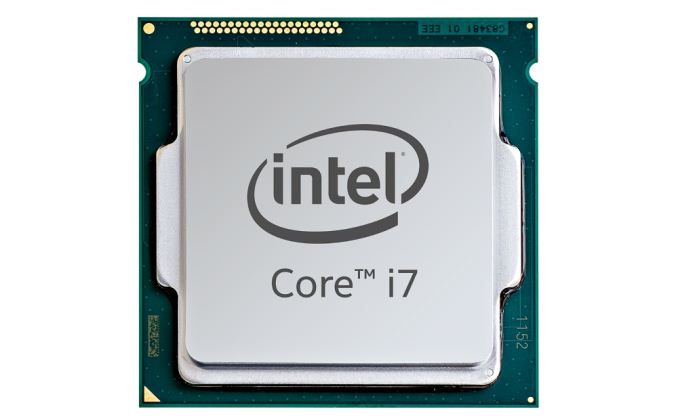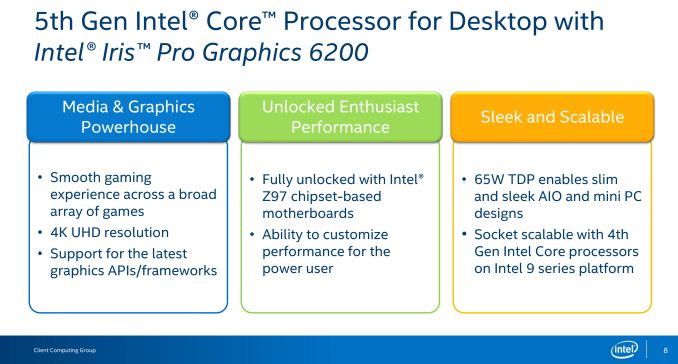The Intel Broadwell Desktop Review: Core i7-5775C and Core i5-5675C Tested (Part 1)
by Ian Cutress on June 2, 2015 7:45 AM ESTBroadwell-DT: Initial Thoughts
The new Broadwell desktop processors are somewhat out of sync with our regular expectations from Intel. Due to issues surrounding the 14nm node, as well as the cost, the whole Broadwell line from tablet to table-top has come out slower and more staggered than any Intel release in recent memory. As a result, the initial launch from Intel today is a pair of 65W desktop socketed models backed up with three 65W soldered down models whose true heritage is a chip primarily designed for large laptops and all-in-one devices.
Normally we would expect a range of desktop models from 35W up to 88W or higher, but socketed Broadwell-DT today only exhibits two units at 65W. This immediately puts a slight damper on those expecting to upgrade from Haswell’s high-end, or those wanting to go from something like a Pentium G3258 on Haswell to Broadwell’s top SKU. As a result, we have to keep our expectations in check – 65W should on paper perform nearly as well as an 88W part would, except it would be reduced by several hundred MHz. Meanwhile as these processors are also fully-unlocked and overclockable, we're left to ponder whether or not the stock frequencies actually matter in that case.
Due to the differential tangent at play, these processors also exhibit Intel’s best integrated graphics package, Iris Pro (GT3e), previously reserved only for soldered down/laptop/mini-PC orientations. This graphics package comes with largest number of execution units available from Intel, 48, alongside 128MB of eDRAM that acts almost like an L4 cache. This helps alleviate memory bandwidth pressure by providing a large(ish) pool near the CPU but with lower latency and much greater bandwidth than main memory. The eDRAM has the greatest effect in graphics, but we also saw some moderate increases in our non-3D regular benchmark suite.
The benefit of the graphics package, Iris Pro 6200, means that Broadwell-DT takes the crown as the fastest socketed graphics available. Our testing showed that the even the second-tier socketed SKU, the i5-5675C, outgunned the previous title holder, AMD’s A10-7870K. Despite having the i7-5775C in to test, due to time and firmware issues, we were unable to run the numbers on the integrated graphics but will do so in a later piece.
The key element to Broadwell-DT is not to consider it a natural successor to Haswell. It doesn't so much replace Haswell-K at this time, so much as it occupies a space Intel has left neglected since the launch of Haswell – the ultimate Intel integrated graphics solution. For users on integrated graphics, where money is no object, Intel now offers you the option to combine the regular CPU performance associated with Intel and a GPU that has the added performance benefits of on-chip, high-bandwidth eDRAM. The only question is whether that combined performance is worth the potential cost, and some would say no, pointing at a combined APU + GPU solution for equivalent or better gaming performance for the same price.
Pricing for the i5-5675C is listed as $276, slightly higher than the price of the i5-4690K which is at $236 on Amazon (reduced from $265). The i7-5775C is a bit higher at $366, also a margin higher than the i7-4790K which is $339 (reduced from $380). This makes Broadwell a tough sell right now in most circumstances unless you are absolutely limited to integrated graphics and want the best solution possible in a configurable PC. Given that Intel has also mentioned Skylake in their recent Computex keynote, it implements an abnormal situation that Intel has never been in with a new platform being talked about in the same breath. We have been told that these parts exist because users wanted them, and it has been interesting to see just how the added eDRAM changes the performance with discrete graphics in the mix.












196 Comments
View All Comments
Zingam - Wednesday, June 3, 2015 - link
Well, nothing to see here! Move along, sir!Where is the Skylake?
ryrynz - Wednesday, June 3, 2015 - link
Ian, what driver was used? Intel just released a new one with some significant performance improvements (15.36.21.4222) Retest?Phartindust - Wednesday, June 3, 2015 - link
Please fix the graphs for GRID Min frames, or did the A10-7700k really beat everything else by 10fps?unityole - Thursday, June 4, 2015 - link
"due to time constraint we will save overclocking for part 2" care to explain why both you and tomshardware don't do OC? i have a feeling intel not allowing reviewers to do OC at first for sample, until at least few weeks or even months later.can't blame you though, need to continuously get sample from intel.
unityole - Thursday, June 4, 2015 - link
im extremely interested in OC, voltage used, power consumption and also performance is what we're after, before moving onto skylake.Notmyusualid - Thursday, June 4, 2015 - link
I'll second the request for identical-speed benchmarks too, thanks.albert89 - Thursday, June 4, 2015 - link
I've got to say I like what Intel has done to its iGPU side of the APU no matter how you read this review it actually doesn't look good for them. Overall Broadwell from these results seems to be between 1.5-3 times more expensive than AMD and if that doesn't both you, then its performance in the games above was between 1.6-6 points ahead while in one game beating AMD by 10 points (not good) while AMD beating Intel by 10 fps (nice). And don't forget we are comparing AMD (28nm) against Intel (14nm) which casts a not so flattering picture of Intel. And need I mention the latency gain over AMD, hardly to write home about by Intel. If your an all round user or a gamer the only thing you'll notice from Broadwell is the hole in your wallet.unityole - Thursday, June 4, 2015 - link
true that, most people here are for CPU performance though, doesn't hurt to have additional good IGPU in case of discrete dies on you, can still boot without dGPU and iGPU can still do things at 1080p.NvidiaWins - Thursday, June 4, 2015 - link
Literally no gain over Devils' Canyon.......zodiacfml - Friday, June 5, 2015 - link
Interesting. I could see a particular niche for this for users needing very good cpu performance and wants occasional gaming that is better than an entry level graphics card. Can't wait for overclocking results.I hope prices go down with Skylake's...